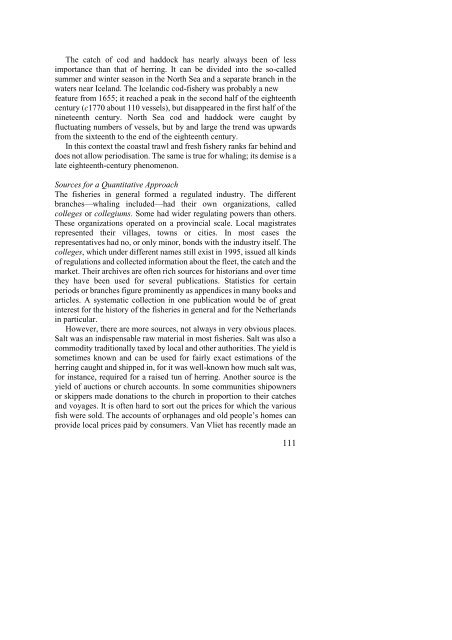The North Atlantic Fisheries, 1100-1976 - University of Hull
The North Atlantic Fisheries, 1100-1976 - University of Hull
The North Atlantic Fisheries, 1100-1976 - University of Hull
You also want an ePaper? Increase the reach of your titles
YUMPU automatically turns print PDFs into web optimized ePapers that Google loves.
<strong>The</strong> catch <strong>of</strong> cod and haddock has nearly always been <strong>of</strong> less<br />
importance than that <strong>of</strong> herring. It can be divided into the so-called<br />
summer and winter season in the <strong>North</strong> Sea and a separate branch in the<br />
waters near Iceland. <strong>The</strong> Icelandic cod-fishery was probably a new<br />
feature from 1655; it reached a peak in the second half <strong>of</strong> the eighteenth<br />
century (c1770 about 110 vessels), but disappeared in the first half <strong>of</strong> the<br />
nineteenth century. <strong>North</strong> Sea cod and haddock were caught by<br />
fluctuating numbers <strong>of</strong> vessels, but by and large the trend was upwards<br />
from the sixteenth to the end <strong>of</strong> the eighteenth century.<br />
In this context the coastal trawl and fresh fishery ranks far behind and<br />
does not allow periodisation. <strong>The</strong> same is true for whaling; its demise is a<br />
late eighteenth-century phenomenon.<br />
Sources for a Quantitative Approach<br />
<strong>The</strong> fisheries in general formed a regulated industry. <strong>The</strong> different<br />
branches—whaling included—had their own organizations, called<br />
colleges or collegiums. Some had wider regulating powers than others.<br />
<strong>The</strong>se organizations operated on a provincial scale. Local magistrates<br />
represented their villages, towns or cities. In most cases the<br />
representatives had no, or only minor, bonds with the industry itself. <strong>The</strong><br />
colleges, which under different names still exist in 1995, issued all kinds<br />
<strong>of</strong> regulations and collected information about the fleet, the catch and the<br />
market. <strong>The</strong>ir archives are <strong>of</strong>ten rich sources for historians and over time<br />
they have been used for several publications. Statistics for certain<br />
periods or branches figure prominently as appendices in many books and<br />
articles. A systematic collection in one publication would be <strong>of</strong> great<br />
interest for the history <strong>of</strong> the fisheries in general and for the Netherlands<br />
in particular.<br />
However, there are more sources, not always in very obvious places.<br />
Salt was an indispensable raw material in most fisheries. Salt was also a<br />
commodity traditionally taxed by local and other authorities. <strong>The</strong> yield is<br />
sometimes known and can be used for fairly exact estimations <strong>of</strong> the<br />
herring caught and shipped in, for it was well-known how much salt was,<br />
for instance, required for a raised tun <strong>of</strong> herring. Another source is the<br />
yield <strong>of</strong> auctions or church accounts. In some communities shipowners<br />
or skippers made donations to the church in proportion to their catches<br />
and voyages. It is <strong>of</strong>ten hard to sort out the prices for which the various<br />
fish were sold. <strong>The</strong> accounts <strong>of</strong> orphanages and old people’s homes can<br />
provide local prices paid by consumers. Van Vliet has recently made an<br />
111















